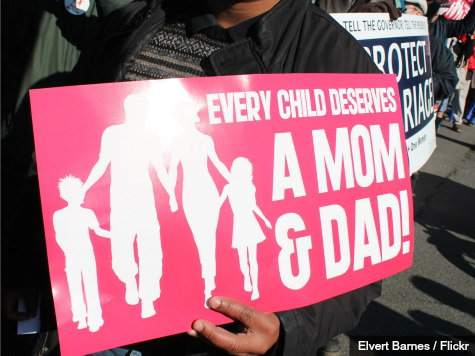
A new study published by the American Enterprise Institute (AEI) finds that family structure and stability are central to the changes in the economic landscape of Americans and their families.
Researchers W. Bradford Wilcox and Robert I. Lerman analyzed 33 years of economic data and found that while much has been written about reasons for the decline of economic life for ordinary Americans, little has been observed about the key role that changes in family formation have on young Americans’ ability to pursue the American dream.
The study verifies that the tendency to normalize unmarried motherhood and fatherhood, especially among lower-income Americans, plays a major role in the economic landscape of family life.
“We estimate that the growth in median income of families with children would be 44 percent higher if the United States enjoyed 1980 levels of married parenthood today,” write the researchers.
The study further finds that, since 1979, family income inequality has grown 32 percent among families with children. In addition, 37 percent of the decline in men’s employment rates, since that time, is associated with the decrease in the number of Americans in stable, married families.
“Growing up with both parents (in an intact family) is strongly associated with more education, work, and income among today’s young men and women,” the authors state. “Young men and women from intact families enjoy an annual ‘intact-family premium’ that amounts to $6,500 and $4,700, respectively, over the incomes of their peers from single-parent families.”
Additionally, the authors observe that married men and women benefit financially from marriage in that both enjoy significantly higher family incomes compared to single peers with otherwise similar characteristics.
The researchers say being raised by both parents in a stable marriage and having higher income are two trends that reinforce each other.
“Growing up with both parents increases your odds of becoming highly educated, which in turn leads to higher odds of being married as an adult,” say the authors. “Both the added education and marriage result in higher income levels.”
Wilcox and Lerman note that these trends apply across the population, regardless of race and education levels. For example, married black men obtain a “marriage premium” of at least $12,500 in individual income compared to single black men.
According to the study, compared to her peers raised by a single parent, a girl who is raised in a married, two-parent home has better chances of success in school, the workplace, and in her own family life. At age 30, she is likely to be working an average of 179 more hours per year, and earning an average of $4,735 more in annual income. Additionally, she is nine percent more likely to have graduated high school, 12 percent more likely to be married, and 12 percent less likely to have become an unmarried mother.
A boy raised in a similar two-parent, stable family is likely to be working an average of 156 more hours per year than his single-parent family peers, and earning an average of $6,534 more in annual income. The boy is 15 percent more likely to have a high school diploma, 10 percent more likely to be married, and five percent less likely to have become a noncustodial father.
The researchers suggest that decreases in the tendency to marry, along with gradual acceptance of children born out of marriage, have led to significant declines in stable two-parent families. In turn, unstable families have aggravated problems associated with poverty, increased inequality, and economic stagnation.
Though the study is correlational and does not draw conclusions from a causal model, the authors state that “the evidence is widespread and consistent enough to suggest strong, causal positive roles for being raised in an intact family and for current marriage on a range of important economic outcomes for the average American.”
Photo Credit: Flickr/Elvertbarnes

COMMENTS
Please let us know if you're having issues with commenting.